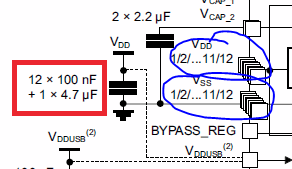Each of your decoupling capacitors exists to provide current when the load (your MCU) switches and needs more current very quickly. The power supply takes time to respond to this transient demand and increase its current output to stop the supply rail falling. The connections to the power supply have an impedance that also slows its response to the load. So you have decoupling capacitors that supply these fast transient currents as needed when MCU switching occurs, charging back up when during steady load times.
A capacitor has a capacitance value and, among other characteristics, an Equivalent Series Resistance (ESR) value which is specified at some frequency of operation. The ESR can be seen as a resistance in series with the capacitor.
Using 12 x 100 nF capacitors in parallel and placed closely together instead of 1 x '1200 nF' capacitor would give the same capacitance but with a lower ESR because all the 12 capacitor ESRs are in parallel with each other. It doesn't give an overall 12th of a single capacitor's ESR, because the interconnecting PCB tracks have an impedance, but it's much lower than the ESR of a single capacitor.
Here, your MCU recommends placing a capacitor near to each of many (12?) MCU supply pins. Each supply pin now sees a nearby capacitor with a lower ESR (and therefore a faster transient current response) than if it was one larger capacitor shared between them.


